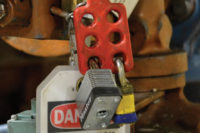Since the days of Thomas Edison’s feud with Nickola Tesla, electrical safety has been a primary concern. Electricity-related injuries account for some of the most serious injuries and fatalities in the workplace.
Most people are aware of the dangers of electrocution — and a healthy respect for the jeopardy posed by electrocution is certainly warranted — but electrocution is hardly the only (or even most serious) hazard posed by electricity. In addition to electrocution, electricity can burn workers, ignite flammable gases, or even explode — throwing sharp metal shards and other materials in all directions. Exposure to electrical hazards takes many forms, including malfunctioning equipment, improperly grounded gear, contact with power lines, static electricity, and arc flash.
Read on for more information about these six common electrical safety scenarios.
1 Damaged equipment
Damaged equipment is a routine source of electrical hazard. Inspect power tools before using. Look for obvious damage like dents, scraped paint, or signs of intrusion of water into equipment, and also signs of wear like frayed power cords or wires.
2 Unsafe proximity to electrical equipment
Many workers get injured by electricity because they work too closely to transformers, for example. Label electrical equipment appropriately and train workers in the importance of keeping a safe distance from it.
Take the case of “Joe” (not his real name). Joe was a stubborn veteran tradesman who knew how to protect himself well enough and didn’t need a safety cop telling him his business. Joe complied with safety regulations religiously, with one exception — he would not remove his wedding ring.
Joe defended his decision by saying, “I love my wife and I put this on when I married her and I intend to wear it when they take me to my grave.” Nothing, not even the threat of write-up, could dissuade Joe or get him to change his mind. As a journeyman electrician most people reasoned that he knew what he was doing — probably better than anybody else. One day, a co-worker came to work and found out that Joe had just been killed. An induction hardener on which he had been working had unexpectedly discharged electricity. The arc flash travelled from the machine to his wedding ring sending enough electricity into Joe’s body to kill him. As far as I know, they buried him with his ring on.
3 Ungrounded or improperly grounded equipment
Properly grounding equipment is a fundamental step in increasing the safety of working with electricity. If one is working with equipment that is improperly grounded, it is likely that he or she will become the ground. Many grizzly workplace fatalities occur because equipment has been improperly grounded. Have a qualified professional inspect the grounding of equipment before work begins.
4 Contact with power lines
A frequent and completely avoidable cause of electrical injuries and fatalities is contact with power lines. Before beginning work, always check to confirm the presence of overhead power lines. If work beneath overhead power lines is unavoidable, ensure that there is sufficient clearance for all equipment that will be used for the job. Another source of danger of contact with power lines is in excavations and digging. Before anyone begins such work, call the appropriate authorities to ensure that there are no hidden electrical (or gas or sewer, etc.) lines buried in the affected area.
5 Static electricity
Static electricity poses a frequently overlooked electrical hazard. Static electricity is a frequent source for flammable vapors. Plastic and cloth seats are excellent sources of static electricity and workers should avoid getting in and out of vehicles in the course of fueling. Avoid using cell phones or other devices that are in plastic cases while working around flammable vapors.
6 Arc flash
When it comes to electrical safety, arc flash still reigns as the hidden killer. When we think about the dangers of electricity, we almost always think about electrocution. While electrocution is a serious electrical hazard, it kills and injures far fewer people than arc flash.
Arc flash is an electric current that passes through air when insulation or isolation between electrified conductors is no longer sufficient to withstand the applied voltage. According to the Bureau of Labor Statistics, 60 percent of electrical deaths are caused by arc flash, far more than by electrocution. Yet many in the workplace are ignorant of the risks posed by arc flash.
“Arc flash is an under-appreciated hazard, often ignored. But it needs to be taken seriously,” said William S. Howard, Ph.D., a specialist in machinery safety. “Probably the best single step that companies and individuals can take is to familiarize themselves with — and follow — all of the arc flash safety protocol that can be found in NFPA 70E: Standard for Electrical Safety in the Workplace. This standard was originally developed at OSHA’s request, and documents the steps necessary for individuals to avoid workplace injuries and fatalities due to electrocution and arc flash.”
Proper labeling is the best protection against arc flash injuries. When labeling potential sources of an arc flash, it’s important to completely identify the hazards. This means identifying arc flash ratings and voltage, and what the cabinets contain and control.
Companies that value electrical safety use labels that demonstrate the correct way to throw an electrical main disconnect (standing to the side and facing away from the disconnect) and the importance of wearing the appropriate personal protective equipment (PPE) — such as gloves rated for the appropriate flash rating — and taking reasonable precautions (no jewelry).
“Arc flashes typically occur when an electrician is working in a panel where only part of the electricity for that panel has been shut off (and under lockout/tagout),” said Joe Eudy, Impact Safety. “Electricians should wear the proper rated flame-resistant (FR) clothing and helmet, in addition to the standard electrician glove sets, rubber sole shoes and proper undergarments.”
Many electricians choose to create their own arc flash labels with mobile labeling systems.
Electricity is unpredictable. And yet many organizations still fail to adequately address this threat through awareness campaigns, signs and proper labeling, investment in appropriate PPE, and training all personnel in the dangers posed by exposure to electricity.




